Change Management: Strategies, Models, and Barriers
Added on 2023-05-27
36 Pages7158 Words120 Views
Running head: CHANGE MANAGEMENT
CHANGE MANAGEMENT
Name of the Student
Name of the University
Author Note
CHANGE MANAGEMENT
Name of the Student
Name of the University
Author Note

1CHANGE MANAGEMENT
Table of Contents
Assessment 1...................................................................................................................................2
Assessment 2.................................................................................................................................12
Assessment 3.................................................................................................................................20
Assessment 4: The presentation.....................................................................................................27
Assessment 5.................................................................................................................................27
Assessment 6.................................................................................................................................31
References......................................................................................................................................33
Table of Contents
Assessment 1...................................................................................................................................2
Assessment 2.................................................................................................................................12
Assessment 3.................................................................................................................................20
Assessment 4: The presentation.....................................................................................................27
Assessment 5.................................................................................................................................27
Assessment 6.................................................................................................................................31
References......................................................................................................................................33
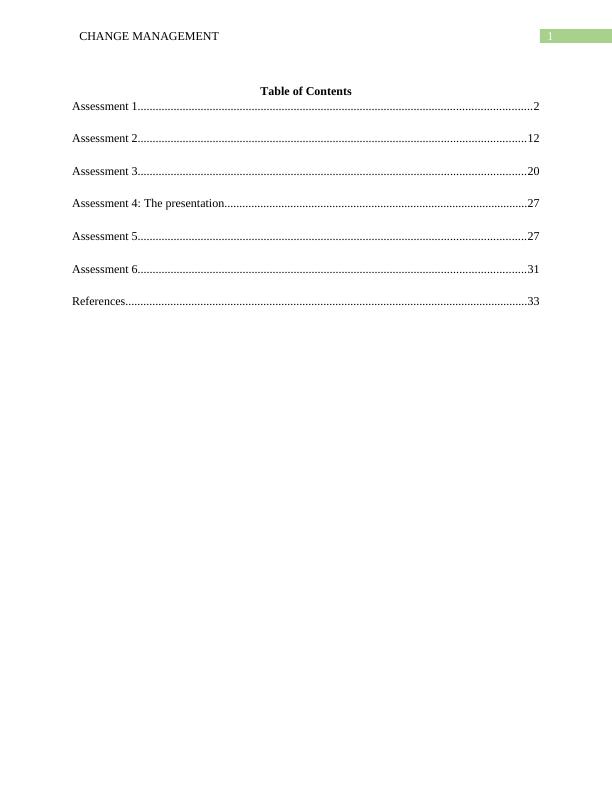
2CHANGE MANAGEMENT
Assessment 1
Answer to Question 1
Organizational change may be considered as an essential aspect of the organization and
may be undertaken by various firms periodically. The different reasons why an organization may
decide to undergo a need to initiate a change can be stated to be as follows:
There may take place certain crisis. The external environment is highly dynamic in nature
and there may take place certain crisis in the external environment of the business and
may lead to certain factors which may lead the organization towards a certain level of
change. This will ensure that the organization is successfully able to survive during the
crisis.
Adaptation to the technology: The technology is evolving considerable and with respect
to this, it is important for the firm to ensure that it is able to initiate the change procedure
in order to be able to adapt to the new technology (Worley and Mohrman 2014). This will
only assist the business to survive amongst the competition.
Mergers and Acquisition: There may take place certain mergers and acquisitions which
may lead to considerable change in the organization due to the new structure and
leadership being adopted.
Answer to Question 2
Although the change may be beneficial for the purpose of the firm, many members of the
organization may resist the change which would take place. The different reasons with respect to
which the members may resist change are as follows:
Assessment 1
Answer to Question 1
Organizational change may be considered as an essential aspect of the organization and
may be undertaken by various firms periodically. The different reasons why an organization may
decide to undergo a need to initiate a change can be stated to be as follows:
There may take place certain crisis. The external environment is highly dynamic in nature
and there may take place certain crisis in the external environment of the business and
may lead to certain factors which may lead the organization towards a certain level of
change. This will ensure that the organization is successfully able to survive during the
crisis.
Adaptation to the technology: The technology is evolving considerable and with respect
to this, it is important for the firm to ensure that it is able to initiate the change procedure
in order to be able to adapt to the new technology (Worley and Mohrman 2014). This will
only assist the business to survive amongst the competition.
Mergers and Acquisition: There may take place certain mergers and acquisitions which
may lead to considerable change in the organization due to the new structure and
leadership being adopted.
Answer to Question 2
Although the change may be beneficial for the purpose of the firm, many members of the
organization may resist the change which would take place. The different reasons with respect to
which the members may resist change are as follows:
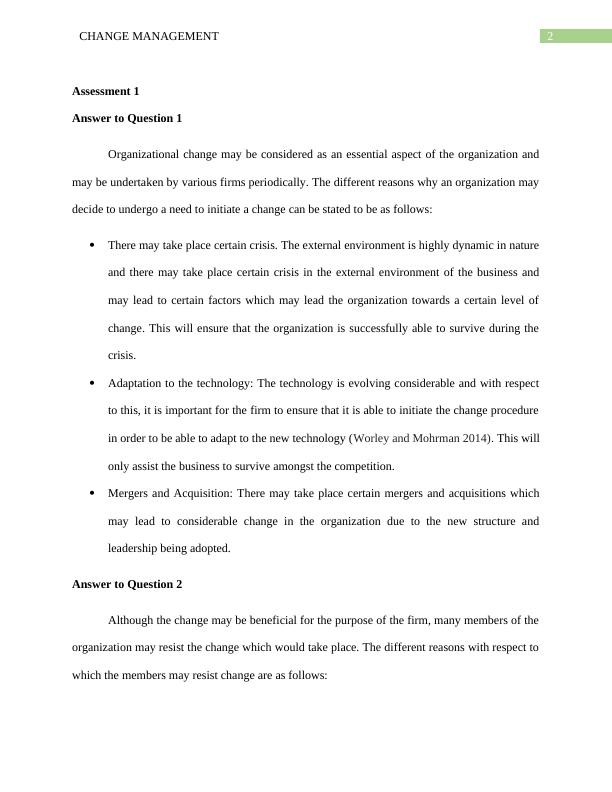
3CHANGE MANAGEMENT
Loss of status or job security: The organizational members often believe that they may
lose out on their jobs due to the change and this is the reason why they may opt to resist
the change. A suggestion to improve the resistance may be that they should be briefed
upon the procedure of change.
Fear of the unknown: Change in a firm brings about other possibilities as well which may
then cause resistance amongst the different employees and cause the members to act
differently (Wheelen et al. 2017). Like the previous step, the members may be brief upon
on the change procedure so as to ensure success.
Organizational politics: The organizational politics may be stated to be another reason
why the different organizational members may resists the change. Lastly, the
management needs to ensure that the system is transparent.
Answer to Question 3
In order to overcome the organizational change resistant’s, it may be considered
important for the firm to form good organizational change strategies. The different benefits of
the change management strategies are as follows:
Helps in convincing the people: A good organizational strategy may go a long way in
ensuring that the firm is successfully able to convince the different people to adopt the
change management procedure. This helps in transiting efficiently.
Helps in aligning the existing resources within the firm: The change management
strategies also ensures that the different individuals are able to align the different
resources in the right manner (Waddell and Sohal 1998).
Loss of status or job security: The organizational members often believe that they may
lose out on their jobs due to the change and this is the reason why they may opt to resist
the change. A suggestion to improve the resistance may be that they should be briefed
upon the procedure of change.
Fear of the unknown: Change in a firm brings about other possibilities as well which may
then cause resistance amongst the different employees and cause the members to act
differently (Wheelen et al. 2017). Like the previous step, the members may be brief upon
on the change procedure so as to ensure success.
Organizational politics: The organizational politics may be stated to be another reason
why the different organizational members may resists the change. Lastly, the
management needs to ensure that the system is transparent.
Answer to Question 3
In order to overcome the organizational change resistant’s, it may be considered
important for the firm to form good organizational change strategies. The different benefits of
the change management strategies are as follows:
Helps in convincing the people: A good organizational strategy may go a long way in
ensuring that the firm is successfully able to convince the different people to adopt the
change management procedure. This helps in transiting efficiently.
Helps in aligning the existing resources within the firm: The change management
strategies also ensures that the different individuals are able to align the different
resources in the right manner (Waddell and Sohal 1998).

4CHANGE MANAGEMENT
The change procedure may take place smoothly: It helps in ensuring that the change
procedure takes place smoothly so as to be able to transit from a poor performance phase
to the right performance phase.
Answer to Question 4
The change management procedure can be stated to be an elongated procedure and with
respect to this, it can be mentioned that, there are several changes as involved in the change
management process. These key phases as present in the change management procedure can be
stated to be as follows:
Preparation: In the preparation procedure it is important for the organization to prepare
for the entire change procedure (Aladwani 2001). This means that the management tends
to send out to the different members that the particular change will take place and that
they will be required to give in their inputs.
Management: This is the management of the actual change transition which exists. There
needs to take place a transition procedure from the old ways to the new ways and with
respect to this, it can be considered very crucial to understand that managing the
procedures is crucial (Todnem By 2005).
Reinforcement: Lastly, the organization will also be required to fix the change which
takes place in the organization and reinforce it into the different operations of the
business at large.
Answer to Question 5
Before proceeding with the change, it becomes crucial for the organization to form a
change management plan. The change management plan will be required to comprise of various
The change procedure may take place smoothly: It helps in ensuring that the change
procedure takes place smoothly so as to be able to transit from a poor performance phase
to the right performance phase.
Answer to Question 4
The change management procedure can be stated to be an elongated procedure and with
respect to this, it can be mentioned that, there are several changes as involved in the change
management process. These key phases as present in the change management procedure can be
stated to be as follows:
Preparation: In the preparation procedure it is important for the organization to prepare
for the entire change procedure (Aladwani 2001). This means that the management tends
to send out to the different members that the particular change will take place and that
they will be required to give in their inputs.
Management: This is the management of the actual change transition which exists. There
needs to take place a transition procedure from the old ways to the new ways and with
respect to this, it can be considered very crucial to understand that managing the
procedures is crucial (Todnem By 2005).
Reinforcement: Lastly, the organization will also be required to fix the change which
takes place in the organization and reinforce it into the different operations of the
business at large.
Answer to Question 5
Before proceeding with the change, it becomes crucial for the organization to form a
change management plan. The change management plan will be required to comprise of various
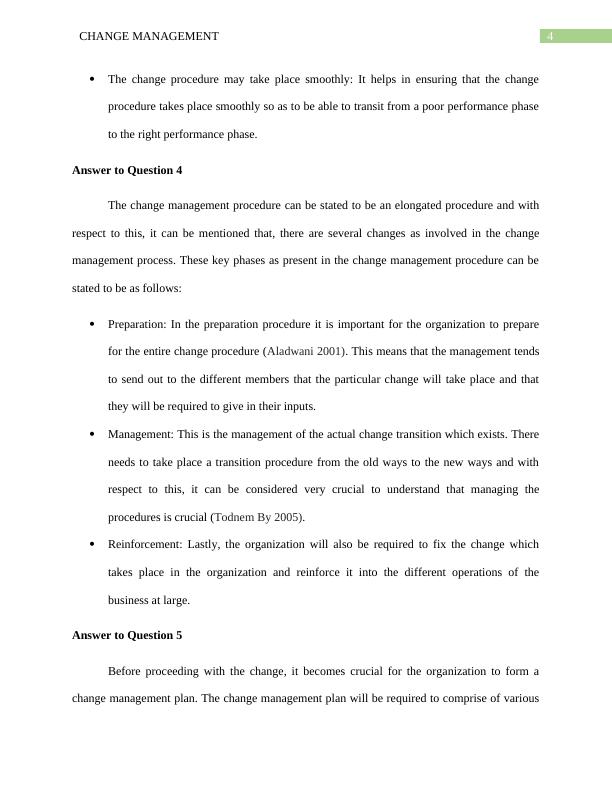
5CHANGE MANAGEMENT
elements which would thereby assist the business in making the different changes as present. The
key elements to be present in the change management plan can be stated to be as follows:
1. The Goal: The first element which is required to be present in the change management
plan is the goal which the organization aims to achieve. This helps in deciding whether
the firm will be able to attain long term success.
2. The Team: The details of the team members will also be given in the change
management plan as in helps in understanding which members will be working for the
particular change procedure.
3. The responsibilities and duties: The duties as well as the responsibilities of the different
team members and their contribution to the change management procedure is also
provided (Ivancevich, Matteson and Konopaske 1990).
4. The outcomes: The expected outcomes of the plan may be mentioned so as to ensure
considerable measurement and assistance option.
5. The procedures: Lastly, the detailed procedure to carry out the particular change in the
organization will also be stated so as to ensure that the team members can follow it
easily.
Answer to Question 6
When an organization plans to undergo a change procedure it is required to ensure that all
the essential aspects of the external environment are considered effectively before actually taking
the particular change decision in hand. In this aspect, the tool of PESTLE Analysis comes as a
useful tool which assists the business to understand the presence of the different factors like the
Political, economic, social, technological, legal and environmental. In this manner, the
organization would be able to gain sufficient information about the overall functioning of the
elements which would thereby assist the business in making the different changes as present. The
key elements to be present in the change management plan can be stated to be as follows:
1. The Goal: The first element which is required to be present in the change management
plan is the goal which the organization aims to achieve. This helps in deciding whether
the firm will be able to attain long term success.
2. The Team: The details of the team members will also be given in the change
management plan as in helps in understanding which members will be working for the
particular change procedure.
3. The responsibilities and duties: The duties as well as the responsibilities of the different
team members and their contribution to the change management procedure is also
provided (Ivancevich, Matteson and Konopaske 1990).
4. The outcomes: The expected outcomes of the plan may be mentioned so as to ensure
considerable measurement and assistance option.
5. The procedures: Lastly, the detailed procedure to carry out the particular change in the
organization will also be stated so as to ensure that the team members can follow it
easily.
Answer to Question 6
When an organization plans to undergo a change procedure it is required to ensure that all
the essential aspects of the external environment are considered effectively before actually taking
the particular change decision in hand. In this aspect, the tool of PESTLE Analysis comes as a
useful tool which assists the business to understand the presence of the different factors like the
Political, economic, social, technological, legal and environmental. In this manner, the
organization would be able to gain sufficient information about the overall functioning of the
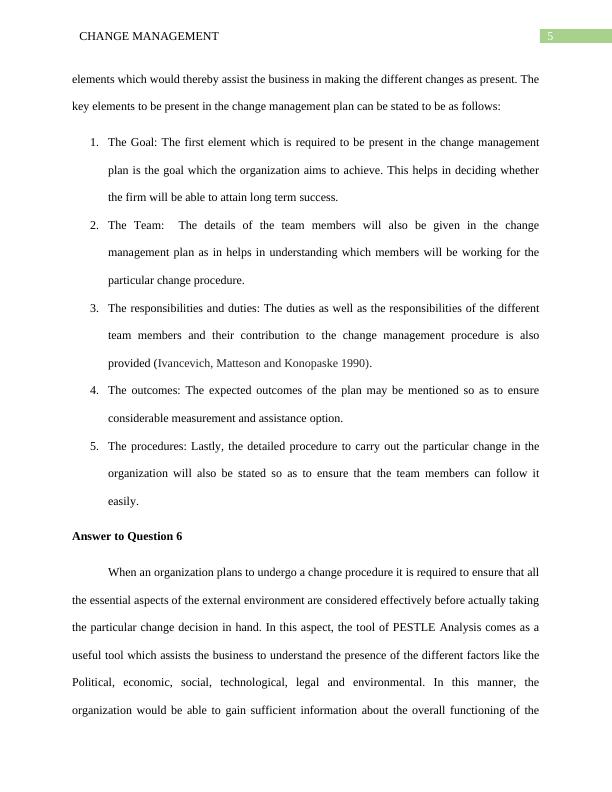
6CHANGE MANAGEMENT
business environment and be able to gain adequate information which assists in ensuring long
term success (Hill, Jones and Schilling 2014). The different elements of the PESTLE Tool can be
stated to be as follows:
Political: This aspect helps in determining the extent to which the government has an
influence on the overall business of the organization.
Social: This factor helps in understanding the manner in which the different lifestyles and
the needs of the customer tend to have an impact on the business operations.
Economic: The economic factors assists in the understanding of whether the economic
policies, rate of growth of the organization and the related aspects tends to have an
impact on the operations of the firm or not.
Technological: The technological aspects may be the growth rate of technology, the
advancement in the machines and other related factors which tend to have an impact on
the operations.
Legal: The legal factors are the legislations and the governmental laws which impact the
overall operations of the business and lead to a sense of allowance to the business to
proceed with the different operations at (Todnem By 2005).
Environment: Lastly, the environmental factors such as emission limitations and other
aspects tend to have a strong impact on the overall operations of the firm.
Answer to Question 7
The Kotter`s 8 step change model can be considered to be a crucial change model which
goes a long way in assisting the different businesses to transit through the change procedure. The
different steps as involved in the model can be stated to be as follows:
business environment and be able to gain adequate information which assists in ensuring long
term success (Hill, Jones and Schilling 2014). The different elements of the PESTLE Tool can be
stated to be as follows:
Political: This aspect helps in determining the extent to which the government has an
influence on the overall business of the organization.
Social: This factor helps in understanding the manner in which the different lifestyles and
the needs of the customer tend to have an impact on the business operations.
Economic: The economic factors assists in the understanding of whether the economic
policies, rate of growth of the organization and the related aspects tends to have an
impact on the operations of the firm or not.
Technological: The technological aspects may be the growth rate of technology, the
advancement in the machines and other related factors which tend to have an impact on
the operations.
Legal: The legal factors are the legislations and the governmental laws which impact the
overall operations of the business and lead to a sense of allowance to the business to
proceed with the different operations at (Todnem By 2005).
Environment: Lastly, the environmental factors such as emission limitations and other
aspects tend to have a strong impact on the overall operations of the firm.
Answer to Question 7
The Kotter`s 8 step change model can be considered to be a crucial change model which
goes a long way in assisting the different businesses to transit through the change procedure. The
different steps as involved in the model can be stated to be as follows:
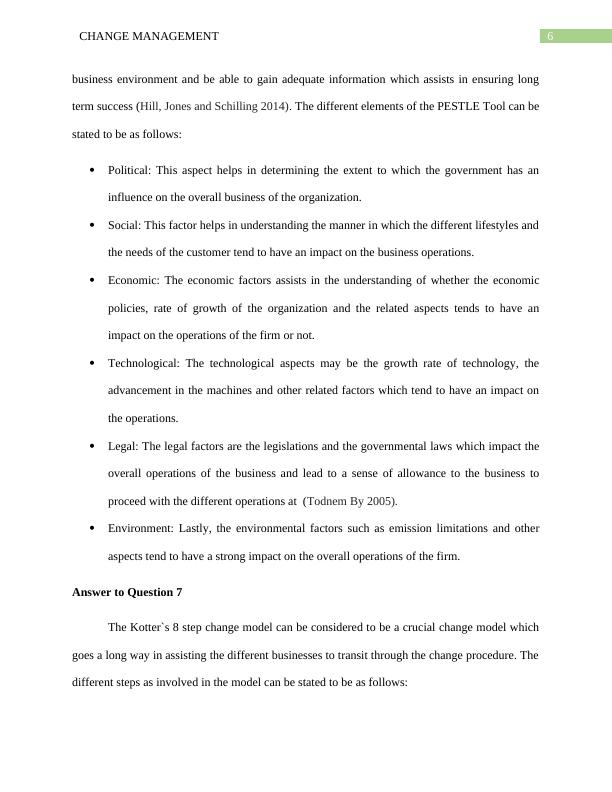
7CHANGE MANAGEMENT
1. Creating urgency: In this step, the organization would be required to create a sense of
urgency regarding the change procedure.
2. Forming a coalition: In the second step, the organization would be required form a
coalition and a list of volunteers who would assist in the change procedure.
3. Creating a vision: In the third step, the organization would be required to create a vision
for the particular change procedure (Hill, Jones and Schilling 2014).
4. Communicating the vision: The vision which has been formed in the previous step needs
to be communicated to the different members.
5. Remove obstacles: The different obstacles as present need to be removed by collective
engagement of the organizational members.
6. Creating short term wins: In this step, the organization would be required to create short
term wins which would ensure success and encouragement.
7. Building on the change: The change which exists and has been fostered needs to be built
upon in the firm at large (Ivancevich, Matteson and Konopaske 1990).
8. Anchoring the change aspects in the corporate culture: Lastly, the change needs to be
anchored to the corporate culture of the firm at large.
Answer to Question 8
The procedure of change is not an easy one and there are various barriers which exist
with respect to organizational change which have been discussed as follows:
The fear of the unknown: There exists a considerable fear of the unknown in the sense
that, the different members as well as the employees are not aware of the consequences
and are hence scared (Anderson and Anderson 2010).
1. Creating urgency: In this step, the organization would be required to create a sense of
urgency regarding the change procedure.
2. Forming a coalition: In the second step, the organization would be required form a
coalition and a list of volunteers who would assist in the change procedure.
3. Creating a vision: In the third step, the organization would be required to create a vision
for the particular change procedure (Hill, Jones and Schilling 2014).
4. Communicating the vision: The vision which has been formed in the previous step needs
to be communicated to the different members.
5. Remove obstacles: The different obstacles as present need to be removed by collective
engagement of the organizational members.
6. Creating short term wins: In this step, the organization would be required to create short
term wins which would ensure success and encouragement.
7. Building on the change: The change which exists and has been fostered needs to be built
upon in the firm at large (Ivancevich, Matteson and Konopaske 1990).
8. Anchoring the change aspects in the corporate culture: Lastly, the change needs to be
anchored to the corporate culture of the firm at large.
Answer to Question 8
The procedure of change is not an easy one and there are various barriers which exist
with respect to organizational change which have been discussed as follows:
The fear of the unknown: There exists a considerable fear of the unknown in the sense
that, the different members as well as the employees are not aware of the consequences
and are hence scared (Anderson and Anderson 2010).
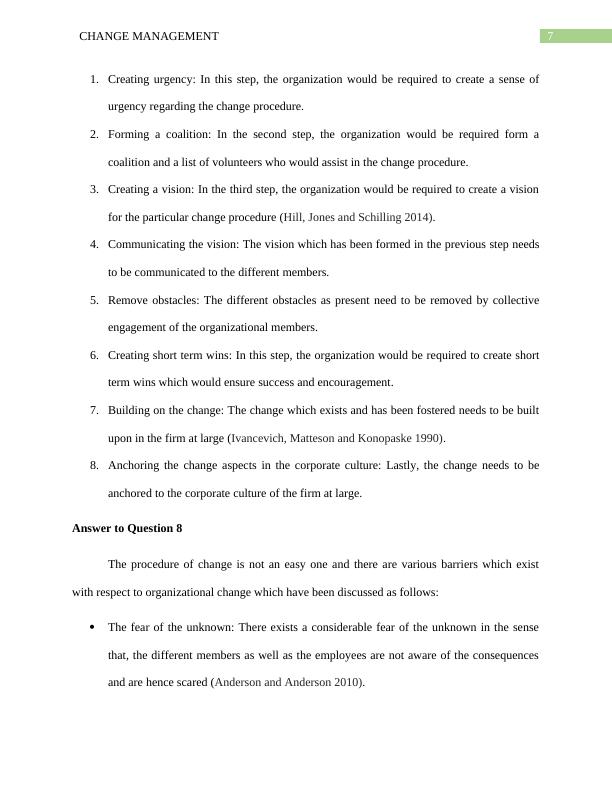
End of preview
Want to access all the pages? Upload your documents or become a member.
Related Documents
Resistance to Changelg...
|7
|2443
|264
Resistance to Change in an Organisation Doclg...
|7
|2765
|66
Business Report on Grace Realty: External Influences, Employee Resistance, and Change Managementlg...
|5
|683
|245
Organizational Innovations and Resistance - Assignmentlg...
|8
|1736
|22
How and why does resistance to change affect the implementation of planned organizational change?lg...
|6
|1626
|321
MGT540 Management of Changelg...
|12
|2924
|44
